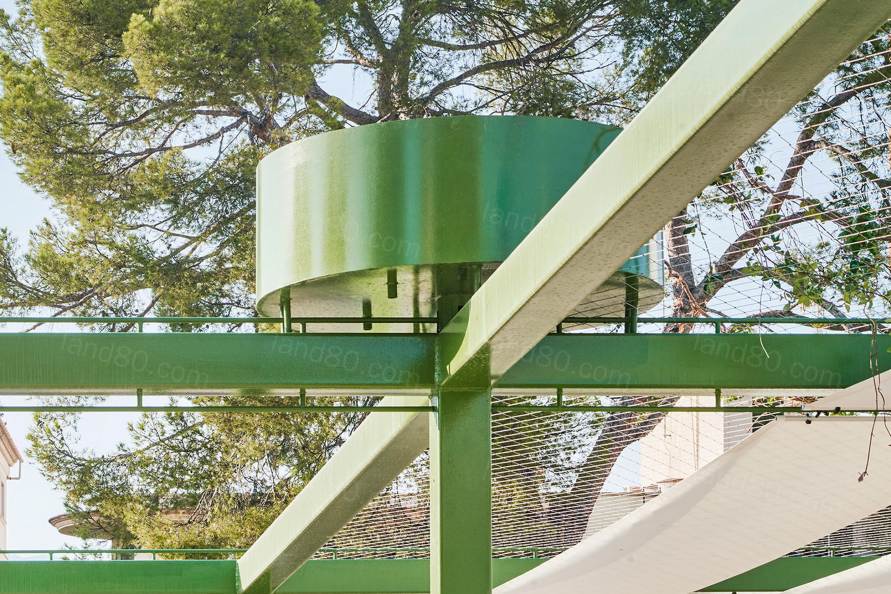这是一个改造现有公共空间的项目。通过使用干预措施增强了现有的质量和元素,并使该场地成为市民未来生活的基础设施。广场位于历史中心和不同城市结构之间的关键位置,人行道和车辆的交通流线都穿过此地。基于这一点,印加市议会在2016年召开了一次公开的整修竞赛。
This is a project for
the transformation of an existing public space. The intervention enhances
existing qualities and elements through its use and enables the place as an
infrastructure for future lives. The plaza is located in a key situation of articulation between the historic center and different urban fabrics, marked by both pedestrian and vehicular traffic flows that cross and surround it. Based on several problems, the city council of Inca convened in 2016 an open competition for its refurbishment.


▽场地原貌

▽改造后


"Fonamental és una
proposta que parteixdelsfonaments de laplaça"。由于两层停车场其中一个出现在地面上,导致广场被一堵4米高的墙、一些服务空间和高大的天窗纵向分割。这套设施产生了一种屏障效应,既在不同层次的公共空间之间,也在人们场地的关系之间。
"Fonamentalésunaproposta
que parteixdelsfonaments de la plaça". The underground physically
conditions the plaza due to the presence of two parking floors. One of them emerges
on the surface, causing the plaza to be divided longitudinally by a 4-meter
high wall, some service spaces and high skylights. This set produced a barrier
effect, both between the different levels of public space and between the
relationships of people in the place.



项目在各层的交汇处采取干预措施,不仅是为了改善广场不同空间和周围环境的整合,也是为了播种、培育和阐明这个公共空间未来的新可能性。在过去被墙隔开的地方,新的人工地形作为看台用于互动。过去人们在夜间黑暗中或在夏季阳光下穿过的地方,如今搭起凉棚,有了树荫、植被和夜间照明,供人们漫步。从前场地缺乏活动空间,现在设有新的活动空间,为广场带来活力。
The project acts at the
intersection between levels, not only to improve the integration of the
different spaces of the plaza and its surroundings, but also to sow, nurture
and articulate new possibilities for the future of this public space. Where the
wall used to divide, there is now a new artificial topography for interaction
(bleachers). Where people used to cross in the dark at night or under the sun
in summer, now there is shade, vegetation and lighting at night for strolling.
(pergola). Where there was no activity, now there is a new space that gives
life to the plaza (local).


这套看台+凉棚+局部的设计是以一种相互联系的方式,超越了组成它的元素的具体性,并克服了其直接或单独的用途。装置纵向穿过广场,被设计成一个可扩展的系统。这涉及到多个标准:建设性、程序性、纪念性、日常性、环境的和整体的生命周期的结合。
The set of bleachers +
pergola + local is designed in an interconnected way, transcending the
concreteness of the elements that compose it and overcoming its immediate or
separate uses. The set crosses longitudinally the plaza and is designed as an
expandable system. This involves combining multiple criteria; constructive,
programmatic, monumental, everyday, environmental and life cycle of the whole.



主要的建设性策略是基于广场的几何重组,以地铁停车场的柱体和板材结构为基础,从而协调整体的几何和结构逻辑。除了新旧结构之间的连续性的建设性论点外,调整的事实为当前配置的未来增长设定了一个明确的标准。这加强了支撑系统延伸到整个广场的可能性。通过这种方式,公共空间回应了一种新的秩序,这种秩序影响了项目的基础设施使命,调整了建设和概念。
The main constructive
strategy is based on the geometric reorganization of the plaza, taking as a
base the structure of pillars and waffle slab of the subway parking lot, thus
coordinating the geometric and structural logic of the whole. In addition to
the constructive argument of continuity between new and old structures, the
fact of aligning sets a clear criterion for future growth of the current
configuration. This reinforces the possibility of the support system extending
throughout the plaza. In this way, the public space responds to a renewed order
that affects the infrastructural vocation of the project, aligning construction
and concept.



团队认为一个公共空间是一个能够通过充分利用现有资源来实现多种活动和情况的空间。从项目的基础设施理解来看,印加的马洛卡广场的翻新改造了一个现有的公共空间,并利用其潜力为其提供新的现在和未来的能力。
We understand that a
public space is one that is capable of enabling a multitude of activities and
situations by making the most of existing resources. From the infrastructural
understanding of the project, the refurbishment of Plaza Mallorca in Inca
transforms an existing public space and takes advantage of its potential to
provide it with new present and future capabilities.
▽场地平面

▽分层平面图
▽剖面图

▽轴测图

General information
Project name:Fonamental –Transformación de Plaza
Mallorca
Architectural office:Son Estudi
Website:www.sonestudi.com
E-mail: hola@sonestudi.com
Country of the office:
Spain
Complete year: 2021
Built area: 5900m2
Location: Inca,
balearic islands.
Architects in charge: Gerardo
Pérez de Amezaga Tomás y Pau Villalonga Munar
Technical architect: TomeuRamon
Clients: Ayuntamiento
de Inca / https://incaciutat.com/es
Engineering: Jordi
Grimalt
Construction company: Obras MAN
Photo credit :José Hevia,Grimalt de Blanch, Son
Estudi.
|